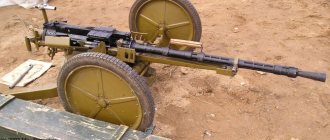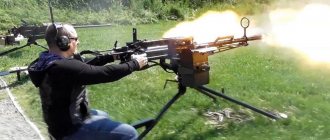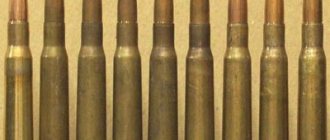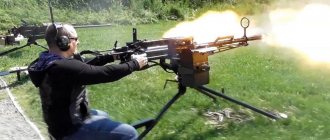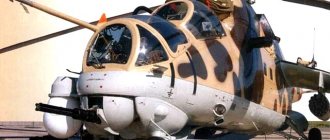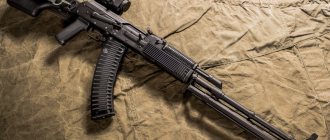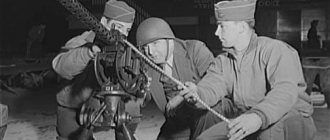The development and production of heavy machine guns is a segment of the arms industry that is extremely conservative. Suffice it to say that the DShK is produced and in service to this day. And M2HB in NATO countries is generally the only “player on the field.”
However, in the USSR, and then in Russia, during the post-war decades they managed to produce as many as two generations of heavy machine guns. And if the NSV “Utyos” appeared without much excitement, the 12.7mm KORD machine gun immediately attracted attention due to its unique qualities. In this respect, the KORD can be compared with the ADS assault rifle - the “manual” heavy machine gun surprised no less than the “double-medium” assault rifle.
History of creation
In the 60s, work began in the USSR to create a replacement for the bulky DShK with its clumsy wheeled machine. The weapon that was eventually developed - NSV, also "Utyos" - turned out to be light, reliable and technologically advanced.
It quickly replaced the DShK as a tank anti-aircraft weapon. The NSV also had its shortcomings, but on the whole it was considered a step forward and satisfied the troops. At first glance, there was no reason to change it.
But after the collapse of the Soviet Union, the plant, built specifically for the production of NSV, remained in Kazakhstan. Despite the rather warm relations between the countries, this became the impetus for the development of a new weapon that would surpass the Utes in terms of characteristics.
By the end of the 90s, a pilot batch was assembled, and since 2001, the sample, called “KORD”, entered mass production. The sonorous abbreviation stands for “Kovrov Gunsmiths-Degtyarevtsy” or, according to another version, “Design of Gunsmith-Degtyarevtsy”.
Origin story
To begin with, we need to say what it even is. Kord is a Russian-made heavy machine gun, belt type, the main purpose of which is the destruction of armored and airborne systems with a range of up to 2000 meters. The name was formed in honor of its creators. It was launched after the collapse of the USSR in the 90s, when the producers of NSV or Utes were pushed beyond our borders. The first to take responsibility for the launch was the plant in the city of Kovrov named after Degtyarev. By 2001, production was established and became serial. It was accepted into service. It was designed by V.I. Zhirokhin, Yu.M. Bogdanov, A.A. Namitulin, N.M. Obidin.
Device
In appearance, the KORD heavy machine gun is almost no different from its predecessor, the NSV. But its design has undergone changes. The automation still works on the principle of removing powder gases, but the wedge locking of the barrel has been replaced by a rotating bolt. The quick-release barrel, manufactured using new technology, has an increased service life.
The plant claims that the survivability of the barrel reaches ten thousand shots - NSV barrels in combat conditions sometimes did not withstand even four thousand.
The place of the conical flash suppressor was taken by a muzzle brake, which reduces recoil. The cartridge belt can be fed from both the right and left sides, and the ejection of cartridges forward has also been preserved. The procedure for disassembling and assembling is basically similar to those for the “Cliff”.
The standard sight is an open sector one, “by default” set at a distance of 400m. It is possible to install optical and night sights, primarily the SPP or SPP-M sight. When creating weapons, we tried to preserve the possibility of using them from existing installations. Therefore, initially KORD used a 6T7 machine from Utes.
Later, an improved 6T20 machine gun appeared, allowing it to fire at low-flying targets. The KORD on such a machine bears the index 6P20. Under the designation 6P58, a version with a pivot mounting is produced. In this form, weapons can be placed on ships, carriages, or in helicopter hatch openings. The KORD tank machine gun differs from the infantry machine gun in the presence of an electric trigger. A remote-controlled installation has been developed for the T-90M tank.
But the main feature of the KORD, which immediately made it famous, was the idea embodied in the 6P57 variant.
Instead of a tripod, the body of the machine gun is mounted on a mount that includes a bipod and a butt with a shock absorber. Even at Utes, the classic handles for heavy machine guns and the trigger on the butt plate were replaced with a shoulder rest and a pistol grip. Now this thought has reached its logical conclusion.
The idea of a “conditionally light” machine gun is not so new - for example, the Germans tried to use aviation MG-131 in this capacity. But there, despite the large caliber, low-power cartridges were used, while KORD uses a “full-weight” 12.7 mm caliber.
Of course, the 6P57 can only be called “manual” in quotation marks, but it has its advantages - first of all, the ability to place a firing position where a tripod simply won’t fit. In addition, such weapons, if necessary, can be moved quickly enough by one fighter. And to install it on a 6T20 machine, it is not necessary to remove the machine gun body from the bipod. But it’s probably not worth talking seriously about effective fire from the hip.
The basic ammunition is considered to be the B-32 armor-piercing incendiary bullet and the BZT-44 armor-piercing incendiary tracer bullet. Despite the fact that the digital designations indicate the venerable age of the design, the bullets have been repeatedly modernized and are modern means of destruction. The B-32 is guaranteed to penetrate 20mm armor, the BZT-44 – 16mm. They can be supplemented by armor-piercing incendiary bullets BS with a tungsten carbide core and explosive bullets MDZ-M.
Review of the 12.7 mm KORD/6P50 machine gun
Review of the KORD machine gun Photo of the KORD machine gun. Selection-1 Photo of the KORD machine gun. Selection-2 Photo of the KORD machine gun. Selection-3 Box for machine gun belt chambered for 12.7x108 mm cartridges
The KORD machine gun was created on the basis of the NSV Utes machine gun in the Russian Federation at the Kovrov Arms Plant named after. Degtyareva. Work on creating a machine gun began after the collapse of the USSR and ended in 1998 chambered for 12.7x108mm. The creation of the machine gun was carried out by Yu.M. Bogdanov, V.I. Zhirokhin, N.M. Obidin, A.A. Namitulin.. The abbreviation KORD stands for “Kovrov gunsmiths of tar.” The large-caliber rifle KORD “St. John’s wort” is produced under the same name. According to military documents for the Russian Army, it is designated GAU- 6P50 . The machine gun is designed to fire at enemy personnel located behind light-medium fortifications, at light and medium armored vehicles at a distance of 1500-2000 meters, and at low-flying aircraft and helicopters at a distance of up to 1500 meters.
The reason for the appearance of the KORD machine gun was the lack of production of large-caliber machine guns on the territory of the Russian Federation, since the NSV Utes heavy machine gun, which was in service with the Soviet army. NSA "Utes" was/is produced in Kazakhstan. Accordingly, after the collapse of the Russian Federation, it was left without its own plant for the production of heavy machine guns. To reduce costs when arming the Russian Army with a new machine gun, the KORD was completely identical in weight, size and mounting to the Utes machine gun, which did not require adaptation of the equipment to the new machine gun. Shooting and operation are similar to the NSV "Utes".
Automation
KORD is an automatic weapon chambered for the Soviet cartridge 12.7x108 mm with belt feed. The automatic operation of the machine gun is based on the removal of part of the powder gases from the barrel bore; the gases push the piston with the bolt to complete a new cycle. The cartridge is locked in the barrel by turning the cylinder by the barrel locks (in the Utes, by tilting the bolt). Shooting is carried out from the rear sear. When released, the bolt, moving forward, snatches the cartridge with a pushing motion and sends it into the chamber. To power the machine gun, a 50-round belt consisting of 10-round pieces is used. The tape is suitable for the DShKM and NSV "Utes" machine guns. The machine gun can be powered from both the right and left sides. The barrel of the machine gun is quick-detachable, produced by forging. Unlike the Utes, in the KORD the barrel heats up evenly, which ensures better accuracy of fire by 1.5-2 times compared to the Utes. So, when shooting at a distance of 100 meters, the bullets fall into a circle of 22 cm. The forged barrel and uniform heating of the barrel during shooting significantly increased the service life of the barrel (from 6,000 to 10,000) and reduced the likelihood of a “wedge” during combat - this allows it to be used by calculations during battle one barrel without replacement. The machine gun is cocked using a cable-handle on the right side of the machine gun. After the shot, the spent cartridge flies a couple of meters forward through a special pipe, like the “grandfather” of the Maxim machine gun, which reduces gas contamination in the fighting compartment of the vehicle, and the shooter’s fighting position is not cluttered with cartridges. To reduce recoil, a multi-chamber muzzle brake is provided at the end of the barrel. Each modification of the machine gun by default has a bipod for use in the infantry version. Now, after knocking out (simply removing) a tank or armored vehicle, soldiers can remove the machine gun and fire. Bipods provide shooting from unprepared positions and rapid movement by combat crews (2 people). KORD became the first machine gun in the world capable of firing from a bipod. The KORD machine gun has an open mechanical sight with graduation up to 2000 meters; the machine gun has a mount for an optical sight.
Ammunition
To fire the KORD machine gun, various 12.7x108 mm cartridges are used: armor-piercing, incendiary, weighted, etc. The cartridge was developed in the 1930s for the domestic DShK machine gun. The cartridge has an energy of 19 kJ, which allows it to penetrate 20 mm of armor plate at a distance of 750 meters. Few modern armored personnel carriers or infantry fighting vehicles from around the world can provide side-view protection for the crew during “dagger” fire. The 12.7x108mm can also be called the 50 caliber cartridge. Firing such cartridges at lightly fortified enemy positions turns out to be very effective and demoralizes the enemy, since laying a few bricks is no longer a defense against the enemy.
Visual difference between KORD and NSV “Utes”
The KORD machine gun often confused with the “Utes”, since they are very similar visually and are created with the same size and mounts, but there are a couple of little things that make them possible to distinguish them: - on the belt ejection side, the KORD does not have a guide bar for the machine gun belt; in the area where the barrel transitions into the frame, KORD has no rivets; - the KORD has a muzzle brake, instead of a flame extinguisher (the first samples of machine guns had a tubular muzzle brake); -infantry bipods on machines for the KORD machine gun. -The NSV “Utes” has a folding sighting front sight - a misconception, since folding and non-folding versions of front sights were produced, and a non-folding front sight for KORD is an accurate spear.
At the moment, KORD is being installed on modern armored vehicles of the Russian Army. They began to sell to some countries: Syria, Algeria. Has combat experience of use in Syria and the Russian Federation during the second Chechen Company. Variants of tank-course variants of a machine gun with an electric trigger have also been created. A disadvantage of the KORD machine gun can be called the unmasking effect, when fire flies out from the muzzle brake in different directions, and nearby foliage and dust scatter in different directions. Although this effect can be called conditional, since a firing point with any heavy machine gun will be detected quickly based on other signs. Another drawback is mobility: wide wheels could be added to make it easier for one fighter to change positions. There is practically no possibility of firing from an infantry vehicle at air targets.
Performance characteristics of the KORD/6P50 machine gun
| Number of shots | 50 per strip - 11 kg with box |
| Barrel diameter | 12.7x108 mm |
| Combat rate of fire | 120 rounds per minute |
| Maximum rate of fire | 600 rounds per minute |
| Sighting range | 2000 meters |
| Effective sighting range | 2000 meters |
| Maximum bullet range | 7000 meters |
| Initial departure speed | 830-860 m/s |
| Automation | gas outlet |
| Weight | 25 kg body, 9.25 kg barrel, 9 kg bipod |
| Dimensions | no data |
Distribution and exploitation
So far, CORD has not received significant distribution. This is also explained by the fact that the production of the Utes machine gun was preserved in the countries that produced the T-72 tank under license, including Serbia and Poland. Moreover, both of them managed to begin serial production of NSV chambered for the NATO cartridge 12.7x99mm. An export version of the KORD chambered for this cartridge was in development, but there is no information about its mass production.
In 2013, Finland became interested in the weapon – they were considering the possibility of replacing the NSV in service with it.
KORDs were supplied to Syria, to government troops. There was information about the presence of Kovrov machine guns in Mali and Namibia. But rumors that KORDs are in service with the Donbass republics turned out to be disinformation. The notorious external similarity of the new weapon with the “Cliff” had an effect.
Mass-sized mock-ups of the machine gun were not available for sale.
Modification
Each area has its own, for convenience:
- 6P49 - tank version, with electric trigger, designed to fight targets flying at low altitude, aimed against vehicles;
- 6P50 - for infantry and motorized rifle units;
- 6P50-1 - universal;
- 6P50-2 - installed on cars and tanks;
- 6P50-3 - adjustable to the required height;
- 6P51 - left-hand cartridge loading, used simultaneously with the right-hand one, in paired variations, for marine purposes.
Tactical and technical characteristics of a machine gun and similar models
Let's compare KORD with its immediate ancestors, especially since none of its predecessors are officially considered obsolete. To complete the picture, we will also include “Browning”.
| CORD | DShKM | NSV | M2HB - QCB | |
| Machine gun body weight, kg. | 25,5 | 33,5 | 25 | 38 |
| Weight of the machine gun on the machine, kg | 41,5 | 157 | 41 | 58 |
| Total length, mm | 1625 | 1625 | 1560 | 1656 |
| Barrel length, mm | 1070 | 1070 | 1070 | 1143 |
| Rate of fire, v/m | 750 | 600 | 800 | 635 |
The weight gain is striking in comparison with the DShK. But this gain was achieved back in the NSV. KORD even became heavier compared to “Utes”. But there is no doubt about its advantage in terms of barrel survivability and increased shooting accuracy. The reduced rate of fire is not a disadvantage - this was done for better control of the weapon when firing. Due to the appearance of the “manual” version, tactical flexibility has increased.
And an effective muzzle brake made it possible to cope with the recoil, which forced the machine gunners to push the NSV machine gun to the ground with heavy loads. Due to the same recoil, by the way, it would not have been possible to saw off the trigger mechanism from the tripod and use the “Cliff” for firing from a bipod.
The M2, which is not inferior in weight to the KORD machine gun together with its installation, does not look very advantageous. On the other hand, the mass and low rate of fire allow you to fire accurately without installing a muzzle brake. And for aviation, lightweight versions of the Browning were produced with an increased rate of fire.
KORD, which does not yet have wide distribution or a rich combat history, looks like a rather promising model.
While retaining the best qualities of the NSV, the designers supplemented them with new capabilities. If the weapon manages to capture a sufficiently large segment of the market, then perhaps competitors will begin to create new machine guns capable of firing not only from the machine, but also from a bipod.
There is a concept of “wow effect” - a way of emotional impact. The KORD, being a successful machine gun, achieved this effect to the fullest thanks to its ability to be used without a tripod.
GROM 2014
HK416 A5
Among more or less close analogues, the editors found a civilian (semi-automatic) custom assembly of the G28 rifle worth $4,150.
Image source: warspot.ru
Heckler & Koch were able to increase the reliability of the NK416 automation and make it less sensitive to contamination. In addition, the problem with overheating during prolonged automatic fire, characteristic of the M4, has been eliminated.
Image source: warspot.ru
MOSSBERG 500
Typically, prices for tactical modifications of the “five hundred” start at $500. The Mossberg 500 is one of the most common multi-shot pump action shotguns. First released in 1961. It is now produced in various modifications intended for hunting, police, security guards and self-defense.
Image source: warspot.ru
For military purposes, the Mossberg 590 version is produced, which is distinguished by a different fastening of the barrel to the magazine (nut instead of screw), more durable bluing and a number of other changes.
Image source: warspot.ru
M110
Civilian clones based on the SR-25 rifle (the M110 was also developed on its basis) cost from $7,400.
Image source: warspot.ru
In the Caliber game, this weapon can be equipped with a telescopic stock, an optical sight and a silencer.
Image source: warspot.ru
USP SD
A wide range of pistol modifications are sold, starting at $300. Heckler & Koch USP (Universelle Selbstlade Pistole - universal self-loading pistol) was developed by the German company Heckler & Koch.
Image source: warspot.ru
One of the main features of the pistol is a special mechanism that reduces the recoil force of the bolt by a third. USP SD users include the Polish GROM, the Italian STORMO INCURSORI and many other divisions.
Image source: warspot.ru
The minimum cost of small arms for a three-man GROM 2014 special forces group is $12,950. This amount includes the cost of three USP SD pistols, as well as an M110 rifle, a Mossberg 500 pump-action shotgun and an HK416 A5 assault rifle.
